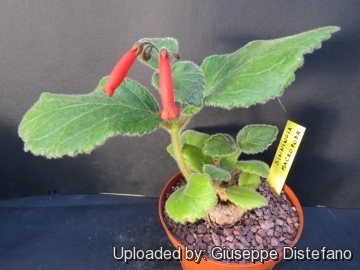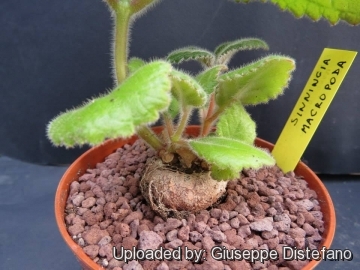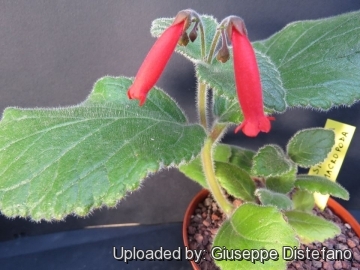Accepted Scientific Name: Sinningia macropoda (Sprague) H.E.Moore
Baileya 19(1): 39. 1973

Corytholoma macropodum (Sinningia macropoda) Photo by: Giuseppe Distefano
Origin and Habitat: Brazil and Paraguay.
Habitat: Sinningia macropodaSN|25980]]SN|25980]] is tuberous plant that grows among rock chunks, with debris, soil and leaf matter, usually at the base of waterfalls under full sun or in shade on the drier sides and in some cases, the mist from the falls would even bathe them as the wind blew the water over them.
Synonyms:
See all synonyms of Sinningia macropoda
back
Accepted name in llifle Database:Sinningia macropoda (Sprague) H.E.MooreBaileya 19(1): 39. 1973Synonymy: 7
back
Common Names include:
ENGLISH: Big Foot Glox
Description: Sinningia macropoda (= big foot ) is a nice, everblooming species with narrow, tubular, orange-red to deep red blooms in clusters at apex with round large exposed tubers and quilted leaves on soft, hairy, stems. This is one of the Sinningia that never really go dormant. When the plant dies back, new sprouts begin to form.
Stems: Up to 60 cm erect, fleshy, striped dark red.
Leaves: Deep green in 4 or 5 pairs; young plants often with only 2 pairs, broadly ovate to 20 long and 15 cm broad. Crinkled, softly short-hairy, cordate at base.
Flowers: 6-18 nodding orange to brilliant red, clustered at stem-apex, axillary, glandular-hairy. Stalks up to 15 cm long. Calyx-lobes triangular up to 2 cm long lender-tipped, hairy. Corolla-tube more or less cylindrical up to 35 mm long, expanding toward apex, glandular-hairy, red. Lobes spreading, more or less equal, lower 3 marked with purple spots or stripes. Disc-glands 2, prominent, or 1 large 2-lobed gland, sometimes also with 3 smaller.
Blooming season: Mainly in summer, but blooms can be produced whenever conditions are adequate.
Bibliography: Major references and further lectures
1) H. E. K. Hartmann “Illustrated Handbook of Succulent Plants: Aizoaceae : A – E” Springer, 2002
2) Alfred Byrd Graf “Tropica: Color Cyclopedia of Exotic Plants and Trees” Simon & Schuster, 01/giu/1978
3) James Cullen, Sabina G. Knees, H. Suzanne Cubey “The European Garden Flora Flowering Plants: A Manual for the Identification of Plants Cultivated in Europe, Both Out-of-Doors and Under Glass” Cambridge University Press, 11/Aug/2011
 Corytholoma macropodum (Sinningia macropoda) Photo by: Giuseppe Distefano
Corytholoma macropodum (Sinningia macropoda) Photo by: Giuseppe Distefano Corytholoma macropodum (Sinningia macropoda) Photo by: Giuseppe Distefano
Corytholoma macropodum (Sinningia macropoda) Photo by: Giuseppe Distefano Corytholoma macropodum (Sinningia macropoda) Photo by: Giuseppe Distefano
Corytholoma macropodum (Sinningia macropoda) Photo by: Giuseppe DistefanoSend a photo of this plant.The gallery now contains thousands of pictures, however it is possible to do even more. We are, of course, seeking photos of species not yet shown in the gallery but not only that, we are also looking for better pictures than those already present.
Read More... Cultivation and Propagation: Sinningia macropoda has a semi-dormant period after flowering (winter rest) and in cultivation comes into growth in early spring. However this is one of the Sinningia that never really go dormant and can easily be induced to remain in almost perpetual growth, with no period of full dormancy. But most plants will produce new and better growth after a period of inactivity. After a period of dormancy the tuber will send up new growth and the cycle will repeat.
Soil: Use a lime free soil that retains water yet drains well with a little added pumice will suffice.
Pots: Always use a pot with a hole and provide a good drainage.
Watering: Drench the soil and let it become moderately dry between waterings when it is in growth and during the winter or dormant season must be kept very much on the dry side. Perpetually wet soil may result in rotting of the tuber, while dry conditions will usually induce premature dormancy.
Fertilization: Needs a regular light fertilization during growing season including all micro nutrients and trace elements or slow release fertilizer at the rate of 1/4 the dose indicated in the label. However some of the more robust cultivars will respond favourably to a more concentrated solution, and some of the smaller cultivars need very little feeding.
Exposures: It requires bright conditions, but not sun and can be grown eventually under bright fluorescent lights or in a greenhouse and many tolerate windowsill conditions if humidity can be kept up and bright light provided without too much direct sun.
Pest & diseases: Prone to mealy bugs. Always inspect any new plant for pests before introducing it to your home or greenhouse.













